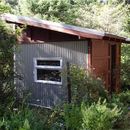Mold on Soffits
Alright mold sleuths, here’s one for you:
I have two sheds, which for practical purposes are identical – except one is insulated and heated, and the other isn’t. The roofs differ in that the tool shed has a single layer of 1/2″ exterior grade plywood as its decking, which is visible from the underside. The she-shed has the same plywood layer insulated with EPS over the heated area, and outside that a 2″ void at the overhangs. Above that is another layer of plywood as the roof substrate. The insulated shed grows a coating of light green mold on the surface of the soffits, the tool shed never does.
A bit of context:
The insulated roof is well air-sealed.
This is in the easy to grow mold PNW climate.
Ideas?
GBA Detail Library
A collection of one thousand construction details organized by climate and house part











Replies
Malcom,
I think if we work backwards we can probably reason out the culprit. Mold only grows when the MC is above 13-14% for an extended period of time. If you have mold, the lower sheathing must have an equilibrium moisture content (EMC) that is above that, and has been for some time. There's a handy set of charts (https://energyhandyman.com/knowledge-library/mold-chart-for-temperature-and-humidity-monitors/) that show the relationship between EMC, RH, and days to mold. That MC can happen when the dew point is in the mid 50's depending on the temperature. Given that you're in the PNW, and winter has just finished, I'd wager that given the shade, vegetation, climate, and season, there are two things happening.
(1) The uninsulated roof gets warm enough to drive out moisture on a daily basis, and that's why you don't see mold growth.
(2) The insulated roof, while lacking insulation around the eaves, has two layers of decking that are trapping moisture between them, and lowering the temperature of the lower decking by some degree. Because there's never direct energy on the lower sheathing, it never gets a chance to dry, and has a higher MC. Thus the mold.
There's a few tests you probably have the tools for that will help us dig deeper. (A) an IR thermometer or a thermocouple, and (B) a wood MC meter. If I were a betting man, I'd wager $1.00 (USD) that at any given time of day the temperature of the soffit on the insulated roof is lower, and that the MC is higher. If you can stick a cheap thermometer on each building, even better.
Don't keep us waiting! This site craves data :).
Any more takers?
Kyle,
I bet you are spot on. It's interesting that the conventional wood soffits on the house right next to it, which experience similar conditions, don't grow any mold. Maybe the plywood is more susceptible? Maybe the venting helps? Either way, the fix would have been to eliminate the double sheathing and gap at the overhangs - or now to maybe provide some venting?
What I'm left with is an hour on a ladder every couple of years wiping it down with Concrobium. Not a big deal. We are in a pattern of poor weather here. I'll try and get some readings once things improve. Thanks.
If the soffits are vented on the house, I would think that there's a lot more drying potential there, which is why you don't see it.
I'm curious now, because back when I built my shed, I tried the vented over roof just so I'd have an install under my belt. From inside to outside right now I've got 2x6 rafters, 19/32 osb, #15 felt, 1.5" foil faced polyiso, 2x4's on the flat, 7/16" OSB, #15 felt, architectural shingles. I ran my polyiso out to the edge instead of stopping it short on the eaves. It's semi heated at the moment.
I'm on the border of zone 3/4 A. I'm actually just painting it now, and will be up on the ladder tomorrow. I'll make sure and take a MC reading, temperature, and note the outdoor RH and temp and post back for comparison. Our nightly lows are in the upper 40's right now, with daytime highs in the mid to upper 70's.
Looking back at old photos of the build, I've just remembered that the ceiling plywood that extends out as soffits on the she-shed is birch GBS. That may play into things.